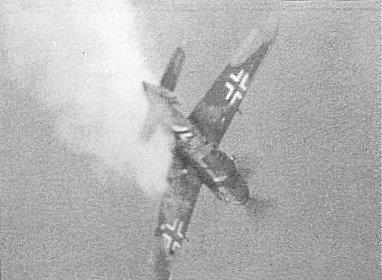|
A Combat Story from 249 Squadron in Sicily: This story comes from the book "Black Crosses off my Wingtip" by Squadron Leader I.F. "Hap" Kennedy: http://ww2today.com/new/2016-2/black-crosses-off-wingtip"Tally ho," I called. "Bullet Red Section. Bandits dead ahead. A little below." We were at 31,000 feet. They were perhaps four miles away and already losing height in a wide sweeping turn to starboard over Grand Harbour. Now they straightened out on a northerly course with their noses down, and I knew they would be exceeding 400 mph. They would be across the seventy miles to Sicily in ten minutes. Unless we could do something about it, that is. I had the throttle open and I rolled over and headed on a course to cut the angle toward the 109s, which had separated a little. I wound on nose-heavy trim so essential to keep the aircraft in a high-speed dive. The Spit responded eagerly as I dove more steeply than the 109s, with Red Two and Three no doubt following, although I could not see them. I could see that I was gaining on the nearest Bf 109. That was something new. We were already half-way to Sicily; that was no problem. We knew from years of experience that the 109 with its slim thirty-two foot wing was initially faster in a dive than we were. We were down to 5,000 feet and our dive had become quite shallow. I could see the Sicilian coast a few miles ahead. Now I was within range at 300 yards, and I let him have a good squirt. The first strikes were on the port radiator from which white smoke poured, indicating a glycol coolant leak. I knew I had him before the engine broke out in heavy black smoke. At that moment a burst of tracer fire went over my starboard wing, quite close to the fuselage. I had lost the third Bf 109, presuming it was way ahead. "Must be behind me," I thought, as I skidded hard to port, then broke around. But there was no 109, only two Spitfires coming toward me. I thought the nearest inexperienced pilot mistook me for the 109. It happened not infrequently, but he was a bit out of range and he missed, and I forgot about it at once in the same way that one forgets about flak that sails harmlessly by the wingtip. We landed at 15:25 hours, having been airborne only 45 minutes. The Intelligence Officer came out to the aircraft to meet me, a very unusual move for that reticent fellow. He waited for me to jump down off the wing. "You got a 109," the I.O. said, smiling broadly. "I believe so," I answered. "It caught fire after I got him in the port radiator. But how did you know?" "Ops called up. Thought we'd like to know. They picked up the pilot's panic call to Comiso for a flying boat. Engine on fire. He was baling out about ten miles south of Pozzallo. He's in the drink." "Well that's good," I said, when he finally stopped. "That's where he belongs. In the bloody drink!" I admitted to feeling some satisfaction from the confirmation of the ME 109G, because it was an excellent German aircraft.  |